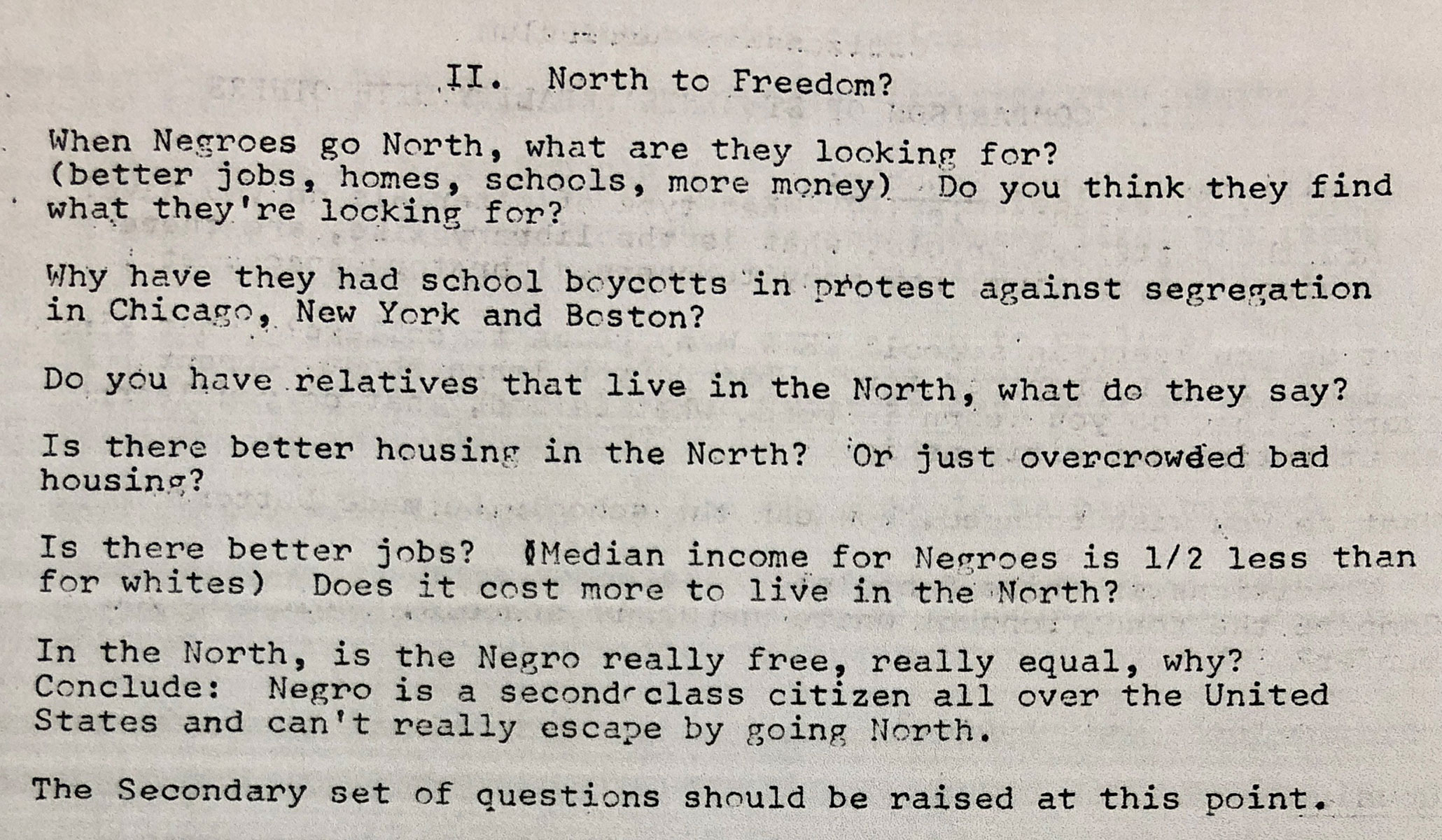You are here:
Freedom School Lesson Plan, excerpt

Date: undated, c. 1964
Caption: Ella Baker and her fellow organizers encouraged the establishment of Freedom Schools in the North. Freedom Schools were learning spaces outside of traditional schools. Baker thought they could help young people to analyze racism and power and its impact on schools and youth. This page captures planning for one Freedom School and its activities.

This proposal for a Freedom School in the North comes after Freedom Summer (1964) in Mississippi and after some of the school boycotts in New York, Boston, and Chicago. It shows Baker’s approach as a teacher. Students at the Freedom School would examine why the boycotts took place, how segregation in the South and the North were similar, and how they experienced racism in places like New York. The outline also shows her insistence that northerners recognize and examine racism on their home terrain, not only in the Jim Crow South.
In the Freedom School classroom, Baker wanted students to think about their history and their current lives. In the Great Migration (1910-1970), millions of African Americans left the South, and the majority moved to cities throughout the North. They hoped to escape the violent repression and limited economic opportunity of the Jim Crow South, and sought jobs in more prosperous northern cities. However, in places like New York, many of those moving from the South quickly realized that northern schools were segregated and unequal, northern policing was brutal and ever-present, employers discriminated on the basis of race, and real estate agents and landlords segregated neighborhoods, leaving Black renters with inferior housing conditions. While many of those who migrated saw improvements in their conditions, racism made African Americans “second-class citizens,” as Ella Baker put it, in the North as well as in the South.
Many white northerners denied that racism existed in places like New York City. They argued that inequality and segregation in education, housing, and the job market was the result of individual choices and supposed cultural differences. They ignored how practices such as redlining and zoning of school districts [/topics/how-did-ny-segregate] produced segregation and sustained inequality. Many white northerners thought of racism as a problem of attitudes, rather than of policies or systems. Thus, young people and their allies who were challenging segregation and inequality in New York had to work within a political system that denied the existence of policies that produced segregation and inequality.
Categories: K-12 organizing, community activism, student activism
This item is part of "Before the Boycotts: Youth Organizing and Direct Action" in "Boycotting New York’s Segregated Schools"
Item Details
Date: undated, c. 1964
Creator: Student Non-Violent Coordinating Committee
Source: Schomburg Center, Ella Baker Papers
Copyright: Copyright status unknown. Courtesy of the Schomburg Center for Research in Black Culture.
How to cite: “Freedom School Lesson Plan, excerpt,” Student Non-Violent Coordinating Committee, in New York City Civil Rights History Project, Accessed: [Month Day, Year], https://nyccivilrightshistory.org/gallery/freedom-school-lesson-plan.
Questions to Consider
- Why do you think the document is titled “North to Freedom”?
- After reading this document, what do you think African Americans migrating from the South to the North found when they arrived there? What different forms did racism take in the North?
- Do you think that discussing the questions and statements for reflection on this page would have prepared Black youth in the North to challenge racism, from white northern liberals and others?
References
How to Print this Page
- Press Ctrl + P or Cmd + P to open the print dialogue window.
- Under settings, choose "display headers and footers" if you want to print page numbers and the web address.
- Embedded PDF files will not print as part of the page. For best printing results, download the PDF and print from Adobe Reader or Preview.
